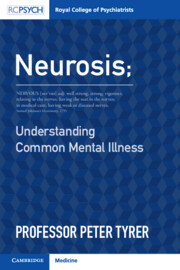Book contents
- Neurosis: Understanding Common Mental Illness
- Reviews
- Neurosis
- Copyright page
- Dedication
- Contents
- Figures
- Tables
- Foreword
- Acknowledgements
- Introduction
- Chapter 1 The General Neurotic Syndrome
- Chapter 2 DSM-III and the Generation of New Diagnoses
- Chapter 3 The Hypotheses of the Nottingham Study of Neurotic Disorder
- Chapter 4 Interpretation of the Results of the 1988 Lancet Randomised Trial
- Chapter 5 The Medium-Term Outcome of the General Neurotic Syndrome
- Chapter 6 The General Neurotic Syndrome at 12 Years
- Chapter 7 The Last Phase
- Chapter 8 Is the Notion of the General Neurotic Syndrome Useful?
- Appendix Personality Assessment Schedule (Tyrer & Alexander, 1979)
- References
- Index
Introduction
Published online by Cambridge University Press: 29 September 2022
- Neurosis: Understanding Common Mental Illness
- Reviews
- Neurosis
- Copyright page
- Dedication
- Contents
- Figures
- Tables
- Foreword
- Acknowledgements
- Introduction
- Chapter 1 The General Neurotic Syndrome
- Chapter 2 DSM-III and the Generation of New Diagnoses
- Chapter 3 The Hypotheses of the Nottingham Study of Neurotic Disorder
- Chapter 4 Interpretation of the Results of the 1988 Lancet Randomised Trial
- Chapter 5 The Medium-Term Outcome of the General Neurotic Syndrome
- Chapter 6 The General Neurotic Syndrome at 12 Years
- Chapter 7 The Last Phase
- Chapter 8 Is the Notion of the General Neurotic Syndrome Useful?
- Appendix Personality Assessment Schedule (Tyrer & Alexander, 1979)
- References
- Index
Summary
Neurosis is passé, neurosis belongs to history, neurosis is dead. So why am I writing this book? The reason is that we need to be aware, even if we do not embrace, information that suggests the way we now look at common mental illness is not necessarily the most accurate or productive way of understanding, and more importantly, treating it. I also introduce this book with the foreword to its predecessor (Tyrer, 1989), written by the late Robert Kendell, and this also explains why I am publishing at this time. Robert, whom I will refer to as Bob from now on, was a stickler for accuracy and rarely wrote anything down that he could not defend with facts. His foreword was written 32 years ago but is just as apposite today – he actually could have written it today with the same wording, and this in itself reflects the poverty of attention that this subject has received since 1989. His statement ‘new concepts should not be adopted until they have been validated by long-term follow-up studies, and the patients with a fluctuating mélange of depressive, anxious and obsessional symptoms are so common that the term “general neurotic syndrome” must be retained to describe them’, is the keynote to this book.
Information
- Type
- Chapter
- Information
- NeurosisUnderstanding Common Mental Illness, pp. 1 - 7Publisher: Cambridge University PressPrint publication year: 2022
